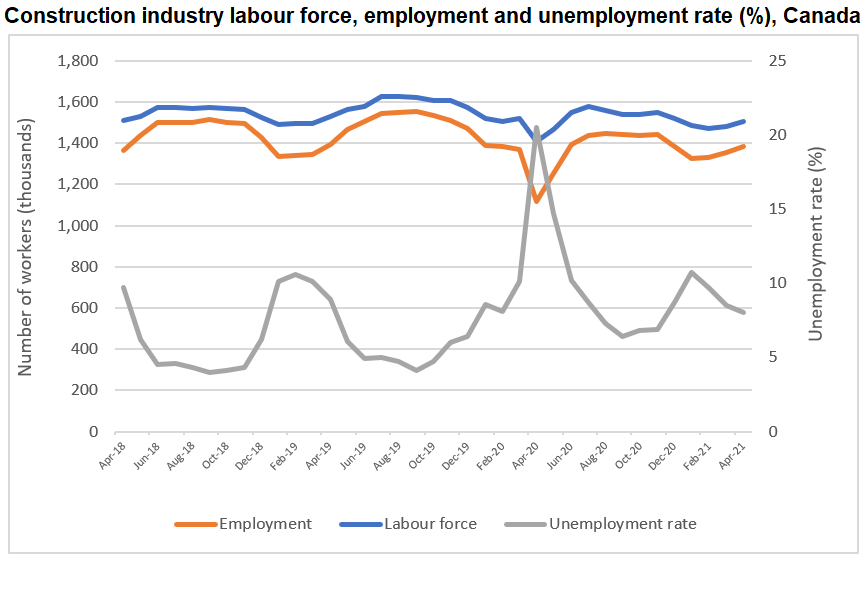For the time being at least, construction has stood strong in the face of the third wave of COVID-19 outbreaks.
Data from Statistics Canada’s Labour Force Survey (LFS) for April shows that sectoral employment rose for the third consecutive month. The industry added 30,700 workers (+2%) for the month, although employment remains about 21,000 workers below pre-pandemic levels recorded in April 2019.
Statistics Canada collected data for its April LFS report during the week of April 11 to 17, and at a time when several provincial governments had tightened public-health measures to control the third wave of the COVID-19 pandemic.
Ontario implemented a province-wide stay-at-home order on April 8 that set restrictions for many non-essential businesses and closed those construction sites considered to be non-essential. British Columbia was under its own “circuit-breaker” restrictions as of March 30, while stricter public-health measures were also re-instated in many parts of Quebec.
According to Statistics Canada, national seasonally adjusted overall employment levels fell by 207,000 (-1.1%) workers, with the national unemployment rate rising to above 8%, and the labour underutilization rate, which captures the full range of people who are available and want to work, increasing to 17%.
Employment declines were severest in those industries most affected by public-health restrictions: retail trade (-84,000), accommodation and food services (-59,000), and information, culture, and recreation (-26,000). Losses were also most significant in those provinces with the strictest lockdown measures, namely Ontario (-153,000, or -2.1%) and British Columbia (-43,000, or -1.6%).
Construction employment trends vary across provinces
Changes in provincial seasonally unadjusted construction employment levels were largely positive in April.

New Brunswick saw construction’s largest month-over-month percentage employment increase at 7%, and its first employment gain since October 2020. Quebec (+6%), Saskatchewan (+5%), and Ontario (+2%) also reported notable gains, while British Columbia, Alberta, and Manitoba saw gains of 1% or less. Meanwhile, the remaining three Atlantic provinces saw employment decreases in April, a fact that was likely due to the growing concern over rising COVID-19 case numbers.
Year over year, construction employment was up 24% nationally, and up significantly in a number of provinces, including Quebec (77%), Nova Scotia (28%), and Saskatchewan (25%). Newfoundland and Labrador was the only province to see an employment decline, falling 3.3% from April 2020 levels.
Also significant is the industry’s continued labour force growth. In the past 12 months, the industry has added more than 99,000 workers. The sector’s overall labour force now counts more than 1.5 million workers.
Those provinces recording the largest year-over-year increases in their labour forces were Nova Scotia (up 5,500 workers, or 16%), Saskatchewan (+5,900, 14%), and Quebec (+33,500, 13%). Prince Edward Island (-8%), Newfoundland and Labrador (-1%), and British Columbia (-0.2%) were the only provinces to report annual declines in their respective labour forces.
Construction operating a higher capacity than a year ago
Construction worked at a much higher rate last month than it did in April 2020, when public-health measures were at their most stringent and restrictions were imposed on certain segments of the industry.
As a result, national total hours worked were significantly higher – up 78% from April 2020 levels and 10% higher than April 2019 levels. The year-over-year gain in hours worked was seen in every province, with Quebec experiencing an increase of 379% from April 2020 levels. Month over month, however, hours worked fell in in Newfoundland and Labrador (-21%), Manitoba (-3%), and Ontario (-5%).

